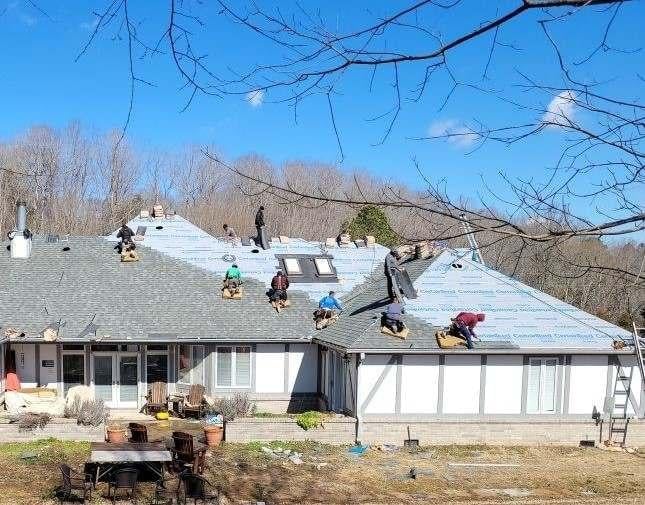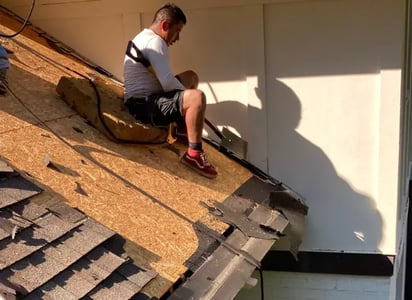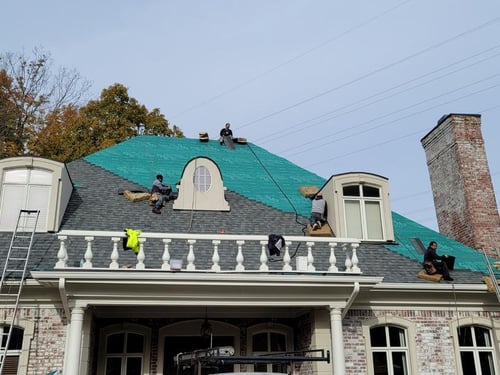So you’ve decided it’s finally time to replace your roof, but you can’t help but wonder, what is the loudest part of this whole process? Well, buckle up because we’re about to uncover the answer. From the pounding of hammers to the shrill noise of power tools, roof replacement can be a symphony of sounds. In this article, we’ll break down the different stages of roof replacement and reveal which one takes the crown for being the loudest. Get ready to have your ears tuned to all the noise that comes with upgrading your home’s roof.

What is Roof Replacement?
Definition of Roof Replacement
Roof replacement refers to the process of removing the existing roof and installing a new one, typically due to wear and tear, damage, or the need for an upgrade. It involves the complete removal of the old roofing materials and the installation of new materials to ensure the structural integrity and protection of the building.
Reasons for Roof Replacement
There are several reasons why roof replacement may be necessary. Over time, roofs deteriorate due to exposure to the elements, including harsh weather conditions, UV radiation, and temperature fluctuations. This can lead to leaks, cracks, and overall decreased performance. Additionally, roof replacement may be required to improve energy efficiency, enhance the aesthetic appeal of the building, or comply with local building codes and regulations.
Understanding Noise Levels
Decibels (dB)
To better understand the noise associated with roof replacement, it is important to acquaint ourselves with the measurement of noise levels. Decibels (dB) are used to quantify sound intensity and determine how loud a particular activity or sound is. The higher the decibel level, the louder the noise.
Comparative Examples
To put the noise levels into perspective, it’s helpful to consider some common comparative examples. A normal conversation typically registers around 60dB, while a vacuum cleaner may generate around 70-80dB. Construction activities, such as hammering, can reach around 90-100dB. It is worth noting that prolonged exposure to noise levels above 85dB can have detrimental effects on hearing.
Identifying Noisy Roof Replacement Activities
During a roof replacement project, there are several activities that can contribute to noise. Identifying these activities can help in understanding the source of the noise and exploring ways to minimize its impact.
Removal of Existing Roofing Materials
The removal of existing roofing materials is often a noisy process. It involves the use of tools such as pry bars, shovels, and hammers to dislodge and remove old shingles, tiles, or metal sheets. This process can generate considerable noise, especially when multiple layers of roofing materials need to be stripped.
Nailing or Stapling
Another significant source of noise during roof replacement is the nailing or stapling of new roofing materials. Roofers use pneumatic nail guns or power staplers to secure shingles, tiles, or metal panels to the roof deck. The repetitive and rapid firing of these tools can produce a loud and continuous noise.
Cutting and Trimming
Roof replacement often requires cutting and trimming of roofing materials to fit the roof’s dimensions. This can involve the use of power saws, shears, or other cutting tools, which can generate noise levels that vary depending on the type of material being cut and the tools used.
Use of Heavy Machinery
In some cases, heavy machinery such as cranes or lift trucks may be required during roof replacement projects. This machinery can contribute to significant noise levels, particularly during the hoisting and positioning of materials or the transportation of equipment.
Impact of Roof Replacement Noise
Effects on Occupants
The noise generated during roof replacement can have various effects on the occupants of a building. Excessive noise can be disruptive, leading to decreased concentration, increased stress levels, and interrupted sleep patterns. It can also disrupt daily activities, making it difficult to work or communicate effectively. For those with sensitive hearing or certain medical conditions, the noise may cause discomfort or trigger symptoms.
Effects on Surrounding Environment
It is not just the occupants of the building undergoing roof replacement who may be affected by the noise; the surrounding environment can also experience its impact. Noise can extend beyond the boundaries of the property, potentially disturbing neighboring buildings, businesses, or even wildlife habitats. Excessive noise can lead to complaints, strained relationships, and potential legal issues.

Regulations and Guidelines
Construction Noise Regulations
To ensure that construction activities, including roof replacement, do not excessively disrupt the well-being of individuals and the community, there are often regulations in place to manage noise levels. Local authorities typically establish sound ordinances that stipulate acceptable noise limits and the times during which construction activities can occur. It is important to consult these regulations and adhere to them during roof replacement projects.
Roof Replacement Guidelines
In addition to construction noise regulations, there may be specific guidelines or recommendations related to roof replacement. These guidelines can provide insights into best practices for minimizing noise during the process, taking into consideration the type of roofing materials, construction methods, and the surrounding environment. Following these guidelines can help ensure a responsible and considerate approach to roof replacement.
Steps to Minimize Noise during Roof Replacement
While some noise may be unavoidable during roof replacement, there are steps that can be taken to minimize its impact on occupants and the surrounding environment.
Selecting Quieter Roofing Materials
One way to reduce noise during roof replacement is by selecting quieter roofing materials. Some materials, such as metal or asphalt shingles, may produce less noise when installed compared to others. Choosing roofing materials that have sound-dampening properties can help minimize noise levels during the replacement process.
Applying Soundproofing Techniques
Applying soundproofing techniques to the roof structure itself can help mitigate noise transmission. This can include adding insulation or sound-absorbing materials between the roof deck and the new roofing materials. These measures can help dampen sound vibrations and reduce noise levels inside the building.
Utilizing Off-Peak Hours
Scheduling roof replacement activities during off-peak hours can be beneficial to both the occupants of the building and the surrounding community. Performing the noisier tasks during times when people are less likely to be affected, such as weekends or early mornings, can help minimize disturbances and reduce potential conflicts with noise regulations.
Notifying Neighbors in Advance
Being considerate and proactive by notifying neighbors in advance about the upcoming roof replacement is essential. Informing them about the expected duration of the project, the potential noise levels, and any measures taken to minimize noise can foster goodwill and mitigate any concerns or complaints.

Hiring Professional Roofers
Choosing Experienced and Reliable Roofing Contractors
When undertaking a roof replacement project, it is essential to hire experienced and reliable roofing contractors. Working with professionals who have a track record of quality workmanship and adherence to regulations can ensure that the project is carried out efficiently and with minimal disruptions.
Discussing Noise Mitigation Strategies
During the hiring process, it is beneficial to discuss noise mitigation strategies with potential roofing contractors. Sharing your concerns about noise and discussing the steps they will take to minimize its impact can help ensure that both parties are on the same page from the beginning. A reputable roofing contractor will be open to addressing these concerns and implementing the necessary measures.
Alternative Roofing Methods
TPO or PVC Membrane Roofing
Considered as an alternative to traditional roofing materials, TPO (Thermoplastic Olefin) or PVC (Polyvinyl Chloride) membrane roofing offers advantages in noise reduction. These single-ply roofing systems have inherent sound-dampening properties, helping to minimize noise levels during installation and throughout their lifespan.
Green Roofing Solutions
Green roofing solutions, such as living roofs or rooftop gardens, can also contribute to noise reduction during roof replacement. The layers of vegetation and soil act as natural sound barriers, absorbing and diffusing sound waves. Green roofing not only helps to minimize noise but also provides additional benefits such as improved insulation, energy efficiency, and stormwater management.
Metal Roofing
Metal roofing is another option that can reduce noise levels during installation and improve long-term acoustic performance. Metal roofs, particularly those with sound-deadening underlayments, can help absorb and dissipate sound waves. This makes them an attractive choice for those looking to minimize noise during the roof replacement process.

Case Studies: Noise Reduction in Roof Replacement
Residential Building Project
In a residential building project located in a densely populated neighborhood, noise reduction during roof replacement was a top priority. The roofing contractor selected materials with sound-dampening properties and utilized off-peak hours for the noisier tasks. They also communicated with the neighbors in advance, ensuring that they were aware of the project details and the measures taken to minimize noise. As a result, the roof replacement was completed with minimal disruptions and no complaints from the surrounding community.
Commercial Roof Replacement
A commercial building undergoing a roof replacement faced similar concerns regarding noise. The roofing contractor recommended the use of TPO membrane roofing, which provided effective noise reduction during installation. They also employed soundproofing techniques, such as adding insulation, to further minimize noise transmission. By working closely with the building occupants and adhering to local noise regulations, the commercial roof replacement project was carried out seamlessly, limiting disruptions to business operations.
Conclusion and Final Considerations
Importance of Noise Awareness
Roof replacement projects are essential for the maintenance and improvement of buildings, but they can generate significant noise levels that impact occupants and the surrounding environment. It is crucial to be aware of the potential noise associated with roof replacement and take proactive measures to minimize its effects.
Balancing Noise Output and Roofing Efficiency
While the reduction of noise during roof replacement is important, it is equally important to balance it with the efficiency and effectiveness of the roofing process. By considering quieter roofing materials, utilizing soundproofing techniques, scheduling tasks during off-peak hours, and communicating with neighbors and stakeholders, it is possible to achieve a successful roof replacement project that minimizes noise while ensuring the integrity and longevity of the new roof.
